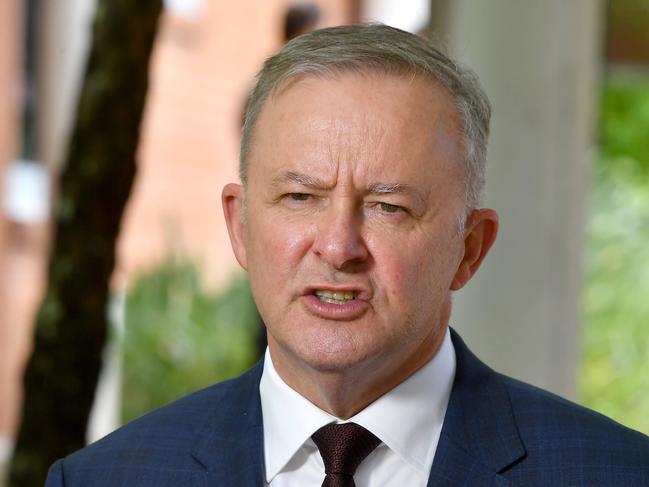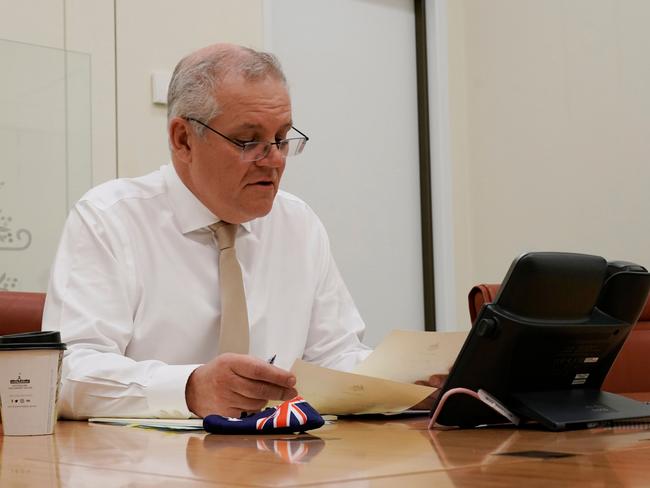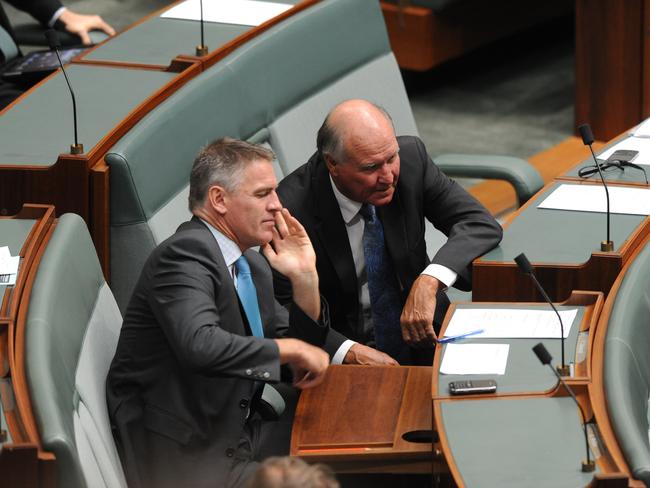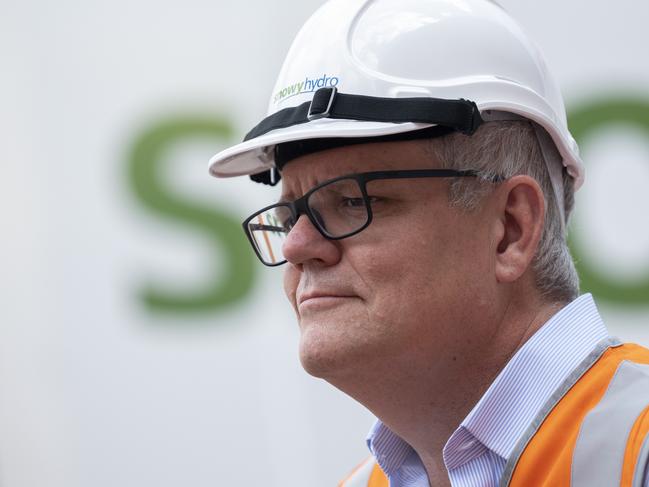Federal Election 2022: What you need to know
From the timing of the next federal election to winner predictions, here’s everything you need to know about the forthcoming vote.
Federal Election
Don't miss out on the headlines from Federal Election. Followed categories will be added to My News.
You’d think that after two years of pandemic pain, we might have been spared the aggravation of a federal election in 2022 - but no such luck. Democracy requires constant attention. Here’s what you need to know about the forthcoming vote.
WHEN IS THE NEXT FEDERAL ELECTION?
Australia’s federal government is voted in for three-year terms, and the election is going to take place on Saturday May 21, 2022.


WHO’S RUNNING IN THE FEDERAL ELECTION?
This election will be a half-Senate election, which means that in addition to electing 151 members of the lower house of parliament, the House of Representatives, citizens in each state and territory will be voting for half the Senate chamber. (A double dissolution election – when all Senators are up for re-election – is called when the government is unable to pass a piece of legislation it badly wants to pass after it has been rejected twice by the Senate.) Some high-profile senators are up for re-election, including Liberals Marise Payne and Simon Birmingham, Labor’s Penny Wong and Matt Canavan from the Nationals.
The contest for control of the lower house will be fought mainly by the Coalition (led by our current prime minister Scott Morrison and Nationals leader Barnaby Joyce) and the Australian Labor Party, led by Anthony Albanese. A number of smaller parties will also be vying for seats, including the Greens (led by Adam Bandt), the United Australia Party (led by former Liberal Craig Kelly), the Liberal Democrats (led by the former Liberal Premier of Queensland Campbell Newman), and Pauline Hanson’s One Nation Party.The past few elections have seen a number of high-profile independents enter parliament, including Helen Haines in the seat of Indi and Zali Steggall, who defeated former prime minister Tony Abbott in 2019 to claim the seat of Warringah.

Haines and Steggall are both recontesting their seats, and they are being joined by a range of independents standing in other electorates. These very loosely affiliated independents – sometimes called the ‘Voices Of’ candidates – are largely challenging sitting Liberals or Nationals, on a platform that calls for more action on climate change. The independents include Monique Ryan, who is taking on Treasurer Josh Frydenberg in the seat of Kooyong; Zoe Daniel, who is up against Tim Wilson in Goldstein; Kylea Tink, who is battling Trent Zimmerman in North Sydney; and Allegra Spender, who is contesting Wentworth, currently held for the Liberals by Dave Sharma.Expect to see vocal, headline-grabbing campaigns from the independents. A number of high-profile Liberal MPs, including Health Minister Greg Hunt and former Attorney-General Christian Porter, are not re-standing in this election, while the Labor Senator Kristina Keneally is attempting to win the lower house seat of Fowler.

The independents include Monique Ryan, who is taking on Treasurer Josh Frydenberg in the seat of Kooyong; Zoe Daniel, who is up against Tim Wilson in Goldstein; Kylea Tink, who is battling Trent Zimmerman in North Sydney; and Allegra Spender, who is contesting Wentworth, currently held for the Liberals by Dave Sharma.
Expect to see vocal, headline-grabbing campaigns from the independents.
A number of high-profile Liberal MPs, including Health Minister Greg Hunt and former Attorney-General Christian Porter, are not re-standing in this election, while the Labor Senator Kristina Keneally is attempting to win the lower house seat of Fowler.
WHO CALLS THE FEDERAL ELECTION?
By custom, the Prime Minister announces the calling of the federal election after meeting with the Governor-General at his residence in Yarralumla. During that meeting, the Prime Minister requests the Governor-General to dissolve parliament and issue writs for an election.
Writs can be issued up to ten days after parliament is dissolved, and then by law the election must be at least 33 days after the issuing of the writs.
HOW DOES THE FEDERAL ELECTION WORK?
Australia is split into 151 electorates, with each one represented by a seat in the House of Representatives. While most seats contain a similar number of voters, there is actually some variation, with the Tasmanian and Northern Territory seats comprising around 70-80,000 electors, and the largest seats across the country topping out around the high 120,000 mark. (Macarthur in NSW has just over 129,000 eligible voters, making it the most populous in the country right now.)
After the results in every seat are confirmed, the leader of the party that can form a majority in the lower house is invited to form a government by the Governor-General.
If no party can form a majority in its own right, the leader must negotiate with other parties or independents in order to form government. This happened in 2010 when independents Andrew Wilkie, Rob Oakeshott and Tony Windsor, as well as Greens MP Adam Bandt, supported Labor to form government with Julia Gillard as Prime Minister.

WHAT DATE DO EARLY POLLING BOOTHS OPEN?
A list of early voting centres is made available in the weeks after an election is announced. In 2019, the early voting booths were open for three weeks before election day, but in 2022 this will be cut to two weeks. However the AEC is also looking at the possibility of extended hours for some early voting centres. These will be heavily advertised in the press and on the AEC website.More than 31 per cent of all votes cast in 2019 were made before election day.
HOW DO PEOPLE VOTE ON ELECTION DAY?
Polling booths open at 8am local time and close at 6pm local time on election day. Once you enter the polling place you will be directed to an official who will ask you your name and address before marking your attendance on the electoral roll. Showing proof of identity is not needed, but the official will also ask you if you have already voted in the election. They will then provide you with the ballot papers – a small green one for the House of Representatives and a large white one for the Senate.Your House of Representatives vote will help decide who represents your local area in our federal parliament, while your Senate vote will help decide who represents your state or territory in parliament’s upper house. The actual marking of your ballot forms takes place in private booths (usually made of cardboard), with pencils provided on strings. Once you have finished, you are requested to fold up your ballot papers and stuff them into the boxes for the House and Senate.If you are attending a voting booth outside your electorate, but still within your state or territory, you can fill in what’s called an Absent Vote for the division you are enrolled in.If for some reason your name is not on the electoral roll, you can fill in what’s called a Provisional Vote, filling in an accompanying declaration form which is also witnessed by an official.
HOW DO PEOPLE VOTE IF THEY ARE INTERSTATE?
If you are interstate on election day, and haven’t done a postal vote or voted early in your home electorate, you can’t just rock up to any old polling place and expect to vote – they won’t have the ballot papers you will need. But you can vote at one of the designated interstate voting centres. The AEC will publish the locations of these centres prior to election day.
HOW DO AUSSIES VOTE IF THEY ARE OVERSEAS?
Besides early voting or postal voting, some Australian embassies set up early voting and election day voting centres in certain locations. But be warned: because of Covid-19 restrictions, there will be far fewer in-person polling booths overseas in 2022. In 2019 there were 85 such locations around the world, but this year it will be fewer than 20.An AEC spokesperson advised overseas Australians to consider a postal vote, but reminded travellers that voting was not compulsory for Australians who are overseas. The most popular overseas voting booth for the federal election has traditionally been the one at Australia House in London, which prior to Covid-19 also had the distinction of being the single busiest polling booth in the entire election.
IS VOTING COMPULSORY? WHAT HAPPENS IF YOU DON’T VOTE?
Voting is compulsory for all Australians aged 18 and over who are enrolled to vote. Those who are not yet enrolled or who have moved since the last election have one week to enrol with the Australian Electoral Commission, or update their details to reflect the electorate in which they now reside. The exact cut-off date for enrolments will also be heavily advertised.The AEC currently has just over 17 million people enrolled at an estimated rate of 96 per cent of the eligible population.Enrolled voters who fail to vote in the 2022 federal election will be forced to pay a $20 administrative penalty, which can be paid online using the Government EasyPay service. The fee is waived for people who provide a valid excuse.Interestingly, the penalty for not voting in the federal election is a lot less than it is for not voting in state elections. (In NSW for example, the penalty for not voting is $55.)“The [$20] penalty is written into legislation and would require the parliament to change it,” an AEC spokesperson said. “It has been discussed as recently as this electoral cycle – the joint standing committee on electoral matters recommended a rise – but it hasn’t changed.We always say that the biggest penalty for not voting is of course missing out on the opportunity to have your say.”
WHAT ARE THE DIFFERENT WAYS PEOPLE CAN VOTE?
Polling places are set up in public schools, community halls and similar spaces. But not everyone can get to a polling booth on election day, so for those who are sick, travelling, heavily pregnant, currently outside their electorate or more than 8kms from a polling place, working on the day, or restricted because of religious observance, early voting and postal voting are also available.After the election is announced, voters can request a postal ballot from the AEC website (www.aec.gov.au) or from their offices. Candidates frequently assist in this process by including postal ballot application forms in their direct mail appeals to voters. Postal votes can be requested up until the Wednesday before polling day.A list of early voting booths will be published in the lead-up to the two weeks they will be open. Simply turn up to the booth and explain why you need to vote early.Voters who are blind, vision impaired or stationed in Antarctica (or en route there) are able to vote via telephone. Details are released by the AEC in the lead-up to election day.
WHAT COVID-19 PRECAUTIONS WILL BE PUT IN PLACE?
This will be the first federal election to take place since the start of the Covid-19 pandemic, so expect a few changes. The AEC will be employing more election day officials in 2022 than ever before, as well as hygiene attendants, who will regularly wipe down voting booths and the supplied pencils. Hand sanitiser will be provided. Voters will not have to bring their own writing implements, and will not need to show any proof of vaccination status. Mask mandates may be in place in particular states or divisions depending on what is happening with the virus. Officials will be masked on the day and it is a condition of their employment that they be vaccinated.An AEC spokesperson warned that Covid-19 protocols meant there was the chance queues for voting could be longer than at previous elections.“Australia is very good in terms of election queues – most people are in and out in around 15 minutes and we never see queues like those reported on the news that last for 9-10 hours in some countries,” the spokesperson said. “However, tolerance isn’t high so we’re pleading for patience if people do experience a queue.”See more about Covid-19 and the election at www.aec.gov.au/election/covid19-safety-measures.htm.
HOW DOES FEDERAL ELECTION VOTING WORK?
From 6pm on election night, in every seat, local counters and scrutineers tally first preference votes and do a two-candidate preferred count, with the aim of working out the probable winner. If no candidate achieves more than 50 per cent of votes, the second preference votes of the candidate with the fewest votes are then counted, and apportioned. If this still fails to put a candidate over the 50 per cent mark, the second preferences of the candidate with the second-least number of votes are then tallied. This process continues until one candidate clears the 50 per cent mark, and a victor is declared.
WHO WILL WIN THE FEDERAL ELECTION?
Popular support for Labor has fallen after the Federal Budget offerings of cheaper petrol and cash handouts as Scott Morrison prepares to call the election.In an exclusive Newspoll conducted for The Australian ahead of a likely May 21 election, it shows Labor’s primary vote falling three points to 38 per cent. However, Labor is maintaining an election winning two-party-preferred result according to Newspoll of 54-46 when preferences are allocated. The Coalition has increased its two-party-preferred result by 1 point to 46 per cent. Labor’s lead has dropped by 1 point to 54 per cent.
Support for Pauline Hanson’s One Nation and Clive Palmer’s United Australia Party remained unchanged with each on 3 per cent of the vote.Support for other minor parties, including independents was also unchanged on 10 per cent.The Coalition primary vote of 36 per cent is the best result for the Liberal and Nationals parties since December – having dropped to as low as 34 per cent – but remains well down on where they would need to be to win an election. Similarly, support for Labor is back to where it was at the end of last year.


But polling companies were criticised for getting the eventual result of the 2019 federal election wrong, and the reality is that our elections are decided not on the general mood of the population, but voting within individual seats. To stay a majority government, the Coalition cannot afford to lose a single seat, and for Labor to form a majority in its own right, it will need to pick up seven seats and not lose any. This will be challenging for both sides, as the Coalition hold two seats with margins of less than one per cent, and Labor have five in that precarious position.
Add the complexities of the pandemic, and the assured position of many state governments right now, and at this stage the outcome of the 2022 federal election is impossible to predict. Stay tuned.
Originally published as Federal Election 2022: What you need to know



